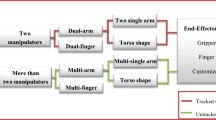Abstract
In this paper, an asymptotically stable optimal control is proposed for the trajectory tracking of a cylindrical robotic arm. The proposed controller uses the linear quadratic regulator method and its Riccati equation is considered as an adaptive function. The tracking error of the proposed controller is guaranteed to be asymptotically stable. A simulation shows the effectiveness of the proposed algorithm.







Similar content being viewed by others
References
Bachrach J, Beal J, McLurkin J (2010) Composable continuous-space programs for robotic swarms. Neural Comput Appl 19:825–847
Bauernschmitt R, Feuerstein M, Traub J, Schirmbeck EU, Klinker G, Lange R (2007) Optimal port placement and enhanced guidance in robotically assisted cardiac surgery. Surg Endosc 21:684–687
Biess A, Nagurka M, Flash T (2006) Simulation discrete and rhythmic multi-joint human arm movements by optimization of nonlinear performance indices. Biol Cybern 95:31–53
Celikkanat H, Sahin E (2010) Steering self-organized robot flocks through externally guided individuals. Neural Comput Appl 19:849–865
Chakraborti T, Sengupta A, Konar A, Janarthanan R (2011) Application of swarm intelligence to a twofold optimization scheme for trajectory planning of a robot arm. In: Lecture notes in computer science, Swarm, Evolutionary and Memetic Computing, vol 7077. Springer, Heidelberg, pp 89–96
Chaoui H, Sicard P (2011) Adaptive Lyapunov-based neural network sensorless control of permanent magnet synchronous machines. Neural Comput Appl 20:717–727
Chen C, Inoue Y, Shibata K (2011) Identification of a golf swing robot using soft computing approach. Neural Comput Appl 20:729–740
Chen CY, Lee CH (2009) Explicit matrix bounds of the solution for the continuous Riccati equation. ICIC Express Lett 3(2):147–152
Chiu C-H (2010) Self-tuning output recurrent cerebellar model articulation controller for a wheeled inverted pendulum control. Neural Comput Appl 19:1153–1164
Christensen DJ, Campbell J, Stoy K (2010) Anatomy-based organization of morphology and control in self-reconfigurable modular robots. Neural Comput Appl 19:787–805
Eronini I, Umez-Eronini (1998) System dynamics and control. Thomson Learning, ISBN: 970-686-041-X
García D, Schiehlen W (2012) 3D-simulation of human walking by parameter optimization. Arch Appl Mech 82:533–556
Ghiasi AR, Alizadeh G, Mirzaei M (2010) Simultaneous design of optimal gait pattern and controller for a bipedal robot. Multibody Syst Dyn 23:401–429
Jang YM, Lee M, Ozawa S (2011) A real-time personal authentication system based on incremental feature extraction and classification of audiovisual information. Evol Syst 2(4):261–272
Jiménez-Lizárraga M, Poznyak A (2006) Near–Nash equilibrium strategies for LQ differential games with inaccurate state information. Math Probl Eng 2006(article ID 21509):1–24
Jiménez-Lizárraga M, Cruz Jose B (2010) New approach to solve algebraic constraints in linear systems using linear dynamical controllers. Int J Innov Comput Inf Control 6(11):4879–4898
Jiménez-Lizárraga M, Poznyak A (2012) Necessary conditions for robust stackelberg equilibrium in a multi-model differential game. Optim Control Appl Methods 33(5):595–613
Koschorreck J, Mombaur K (2012) Modeling and optimal control of human platform diving with somersaults and twists. Optim Eng 13:29–56
Lee W-P, Yang T-H (2011) Combining GRN modeling and demonstration-based programming for robot control. Neural Comput Appl 20:909–921
Leite D, Ballini R, Costa P, Gomide F (2012) Evolving fuzzy granular modeling from nonstationary fuzzy data streams. Evol Syst
Lemos A, Caminhas W, Gomide F (2011) Fuzzy evolving linear regression trees. Evol Syst 2(1):1–14
Leng G, Zeng XJ, Keane JA (2012) An improved approach of self-organizing fuzzy neural network based on similarity measures. Evol Syst
Lewis FL, Syrmos VL (1995) Optimal control, 2nd edn. Wiley, New York, ISBN: 0-471-03378-2
Lewis FL, Dawson DM, Abdallah CT (2004) Control of robot manipulators. Theory and Practice, 2nd edn. Marcel Dekker, Inc., New York, ISBN: 0-8247-4072-6
Rong H-J, Sundararajan N, Huang G-B, Zhao G-S (2011) Extended sequential adaptive fuzzy inference system for classification problems. Evol Syst 2(2):71–82
Rubio JJ, García E, Pacheco J (2011) Trajectory planning and collisions detector for robotic arms. Neural Comput Appl 21(8):2105–2114
Rubio JJ, Torres C, Rivera R, Hernández CA (2011) Comparison of four mathematical models for braking of a motorcycle. IEEE Latin Am Trans 9(5):630–637
Rubio JJ, Vazquez DM, Pacheco J (2010) Backpropagation to train an evolving radial basis function neural network. Evol Syst 1(3):173–180
Spong MW, Hutchinson S, Vidyasagar M (2006) Robot modeling and control. Wiley, New York, ISBN: 13-978-0-471-64990-8
Villaverde I, Graña M (2011) Neuro-evolutionary mobile robot egomotion estimation with a 3D ToF camera. Neural Comput Appl 20:345–354
Wu Y, Sun F, Zheng J, Song Q (2010) A robust training algorithm of discrete-time MIMO RNN and application in fault tolerant control of robotic system. Neural Comput Appl 19:1013–1027
Wu H, Sun F, Sun Z, Wu L (2004) Optimal trajectory planning of a flexible dual-arm space robot with vibration reduction. J Intell Robot Syst 40:147–163
Yin Y, Hosoe S, Zhiwei Luo (2007) A mixed logic dynamical modeling formulation and optimal control of intelligent robots. Optim Eng 8:321–340
Acknowledgments
The authors are grateful to the editors and the reviewers for their valuable comments and insightful suggestions, which helped to improve this research significantly. The authors thank the Secretaría de Investigación y Posgrado, Comisión de Operación y Fomento de Actividades Académicas del IPN, and Consejo Nacional de Ciencia y Tecnología for their help in this research. The fourth author would like to thank the financial support through a postdoctoral fellowship from Mexican National Council for Science and Technology (CONACYT).
Author information
Authors and Affiliations
Corresponding author
Rights and permissions
About this article
Cite this article
Torres, C., de Jesús Rubio, J., Aguilar-Ibáñez, C.F. et al. Stable optimal control applied to a cylindrical robotic arm. Neural Comput & Applic 24, 937–944 (2014). https://doi.org/10.1007/s00521-012-1294-6
Received:
Accepted:
Published:
Issue Date:
DOI: https://doi.org/10.1007/s00521-012-1294-6




